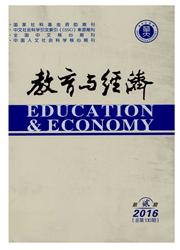

 中文摘要:
中文摘要:
本文基于改革开放以来我国国家财政预算内教育经费以及GDP年度数据,运用“双阶段”马尔科夫区制转移模型,对我国教育投资周期以及宏观经济周期动态过程进行阶段性变迁识别和转移分析。结论表明:(1)教育投资在1983年至2005年间处于“低速增长阶段”,在2006年至2012年间处于“快速增长阶段”。GDP在1995年至2002年间处于“低速增长阶段”,在1983年至1994年以及2003年至2012年间处于“快速增长阶段”。(2)教育投资(GDP)处于“低速(快速)增长阶段”时的持续性强于其处于“快速(低速)增长阶段”时的持续性,教育投资步入“低速(快速)增长阶段”时的持续性强于(弱于)GDP步入“低速(快速)增长阶段”时的持续性。教育投资(GDP)处于“低速(快速)增长阶段”时的波动性高于其处于“快速(低速)增长阶段”时的波动性,教育投资步入“低速(快速)增长阶段”时的波动性强于(弱于)GDP步入“低速(快速)增长阶段”时的波动性。(3)上世纪90年代中期,是教育投资周期与宏观经济周期同步与否的“分水岭”,在此之前,教育投资周期与宏观经济周期变化截然相反,在此之后,教育投资周期与宏观经周期较为同步,但是-9宏观经济周期相比较.教育投资周期具有一定的“时间滞后性”。
 英文摘要:
英文摘要:
This article is based on national financial education expenditure budget and the annual GDP data since the reform and opening up, use of the "ual-stage" Markov regime switch model to identify and analyze the dynamic process of the China's education investment cycle and macroeconomie cycle. The conclusions indicate that: (1) Education investment is in "slow growth phase" between 1983-2005, and in the "rapid growth phase" between 2006-2012 , GDP is in the "slow growth phase" between 1995-2002, and in the "rapid growth phase" between 1983-1994 and also between 2003-2012. (2) The persistence of education investment (GDP) in the "slow (rapid) growth phase" is stronger than it's in the "rapid (slow) growth phase", the persistence of education investment going into the "slow (rapid) growth phase" is stronger (weaker) than GDP going into the "slow (rapid) growth phase". The volatility of education investment (GDP) in the "slow (rapid) growth phase" is stronger than it's in the "rapid (slow) growth phase", the volatility of education investment going into the "slow (rapid) growth phase" is stronger (weaker) than GDP going into the "slow (rapid) growth phase". (3) The mid-1990s is the "watershed" prior to distinguish education investment cycle and macroeconomie cycle is synchronized or not. Before this prior, the change of education investment cycle and macroeconomic cycle is opposite, and after this, education investment cycle and macroeconomic cycle is more synchronized, but compared with the macroeconomic cycle, education investment cycle has a certain "time lag".
 同期刊论文项目
同期刊论文项目
 同项目期刊论文
同项目期刊论文
 期刊信息
期刊信息
